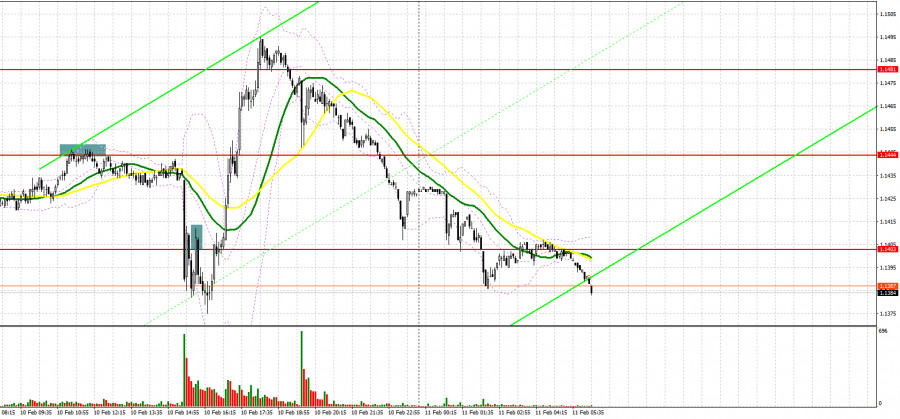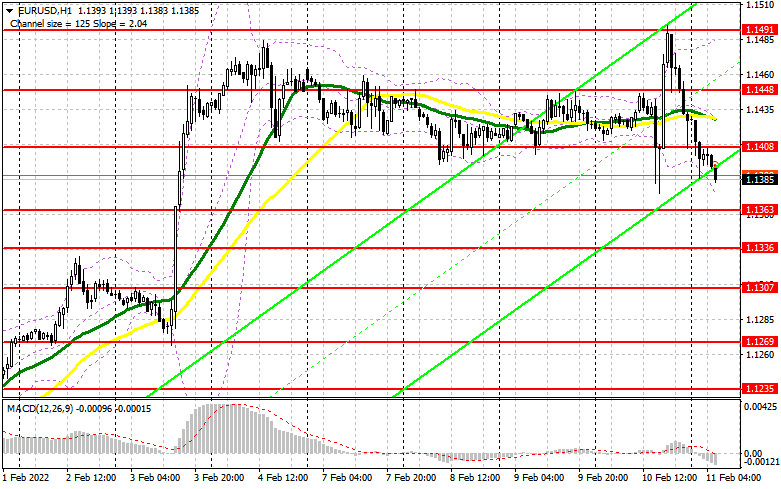
To open long positions on EUR/USD, you need:
Yesterday, several signals were formed to enter the market. Let's look at the 5-minute chart and figure out what happened. In my morning forecast, I paid attention to the 1.1444 level, and also advised you to make decisions on entering the market. Growth to this level again did not bring euro bulls any success, who failed to break through above this range in the first half of the day. Forming a false breakout there resulted in creating a signal to sell the euro, which was fully realized after the publication of data on US inflation. As a result, the drop was more than 40 points. A breakthrough and consolidation below 1.1403 with a reverse test from the bottom up provided another entry point into short positions. This time, the downward movement was another 30 points, after which the pressure on the euro decreased.

The inflation data released yesterday led to a serious surge in market volatility. The reaction to the report was long positions on the US dollar, but then the market turned around and everyone rushed to buy the euro. But according to the results of the day, without crossing the area above 1.1490, the pressure on risky assets increased, which again led to a major sell-off of the euro. Now it is quite difficult to categorically talk about the continuation of the EUR/USD upward trend. It is important to protect the nearest support of 1.1363. Yes, it is this level, which, it seemed, could already be forgotten, that will now save the euro from a new wave of decline. Forming a false breakout at 1.1363 creates an excellent entry point into long positions. However, in order to really count on the EUR/USD recovery, we need strong data on the German consumer price index. Only the growth of data will lead to a return of demand for risky assets. An equally important task is to control the nearest resistance of 1.1408. Crossing this range and consolidating higher will help bulls gain confidence in their actions. A test of 1.1408 from top to bottom will lead to another buy signal and open up the possibility of recovery to the area of 1.1448, just below which the moving averages playing on the bears' side pass. A breakthrough of this range will also open a direct path to the monthly high of 1.1491, where I recommend taking profits. We can count on such strong growth from the euro in case we receive weak data on the US economy in the afternoon. With the pair declining during the European session and the lack of activity at 1.1363, and given yesterday's inflation in the US and future Federal Reserve measures, it is best not to rush into long positions. The optimal scenario would be a false breakout at 1.1336, but you can buy the euro immediately on a rebound from the level of 1.1307, or even lower - around 1.1269, counting on an upward correction of 20-25 points within the day.
To open short positions on EUR/USD, you need:
Yesterday, bears quite unexpectedly returned to the market by the end of the US session, which led to a major drop in the euro to the area of weekly lows. Today, they also have something to count on: data on Germany can seriously harm those who want to buy euros in the morning, and a report on the consumer sentiment index from the University of Michigan will push the euro down even more. In order to maintain control over the market, you need to try very hard not to miss the level of 1.1408 in the first half of the day. Forming a false breakout there, by analogy with what I discussed above, will be a signal to open short positions in order to pull EUR/USD to the area of 1.1363. The breakdown of this area depends entirely on the market reaction to the inflation data in Germany. If we see an exit below 1.1363, a reverse test from the bottom up of this range will provide another signal to open short positions with the prospect of falling to large lows: 1.1336 and 1.1307. A more distant target will be the 1.1269 area. I recommend taking profits there. In case the euro grows and the bears are not active at 1.1408, it is best not to rush with short positions. The optimal scenario will be short positions when forming a false breakout in the area of 1.1448. You can sell EUR/USD immediately for a rebound from 1.1491, or even higher - around 1.1562, counting on a downward correction of 15-20 points.

I recommend for review:
The Commitment of Traders (COT) report for February 1 showed that both long and short positions had increased, and the latter turned out to be slightly more. This led to a slight reduction in the positive delta. However, it should be understood that the data does not take the European Central Bank meeting into account, at which its president Christine Lagarde made it clear to all market participants that the central bank will act more aggressively if the observed picture with inflation does not change.
As the latest data showed, there is no need to wait for a slowdown in inflationary pressure. This is a strong bullish signal to buy the euro at the moment, as there is a real prospect of a tighter monetary policy and an increase in interest rates in the eurozone this year. On the other hand, we should not forget about the Federal Reserve's increase in interest rates already in March this year, which will be some deterrent for EUR/USD bulls. Some traders expect that the central bank may resort to more aggressive actions and raise rates by 0.5% at once, rather than by 0.25% — this will become a kind of bullish signal for the US dollar. The COT report indicates that long non-commercial positions rose from the level of 213,408 to the level of 213,563, while short non-commercial positions jumped from the level of 181,848 to the level of 183,847. This suggests that traders continue to build up long positions, and the future report will clearly indicate a serious advantage in the bulls' direction, as it will take into account the February results of the ECB meeting. At the end of the week, the total non-commercial net position decreased slightly and amounted to 29,716 against 31,569. The weekly closing price also dropped, and amounted to 1.1229 against 1.1323 a week earlier.
Indicator signals:
Trading is conducted below the 30 and 50 day moving averages, which indicates market control on the part of the bears.
Moving averages
Note: The period and prices of moving averages are considered by the author on the H1 hourly chart and differs from the general definition of the classic daily moving averages on the daily D1 chart.
Bollinger Bands
Crossing the lower limit of the indicator in the area of 1.1378 will lead to a larger drop in the pair.
Description of indicators
Moving average (moving average, determines the current trend by smoothing out volatility and noise). Period 50. It is marked in yellow on the chart.Moving average (moving average, determines the current trend by smoothing out volatility and noise). Period 30. It is marked in green on the chart.MACD indicator (Moving Average Convergence/Divergence — convergence/divergence of moving averages) Quick EMA period 12. Slow EMA period to 26. SMA period 9Bollinger Bands (Bollinger Bands). Period 20 Non-commercial speculative traders, such as individual traders, hedge funds, and large institutions that use the futures market for speculative purposes and meet certain requirements.Long non-commercial positions represent the total long open position of non-commercial traders.Short non-commercial positions represent the total short open position of non-commercial traders.Total non-commercial net position is the difference between short and long positions of non-commercial traders.